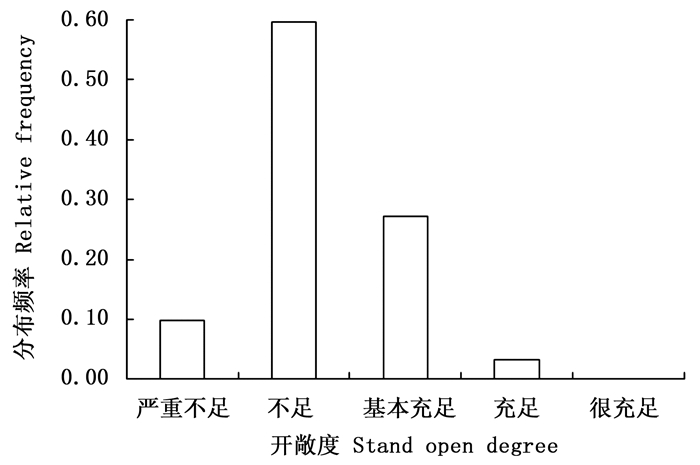-
空间结构是森林结构的最直观表现因子,已成为森林结构研究的热点[1-3]。许多学者就空间结构单元确定[4-6]、空间结构指标量化与选择[7-10]、空间结构分析[11-15]及空间结构优化经营模型[16-17]等方面进行了较为深入的研究,而空间结构评价方面的研究较少[18]。侧柏(Platycladus orientalis (L.) Franco)是北京低山地区重要的造林树种之一,同时也是该地中山和低山的地带性植被类型。侧柏已成为北京市生态公益林的重要组成部分,对北京地区的造林绿化、水土保持、生态环境改善发挥着重要的作用。因其大多为20世纪50至80年代营造的人工林,初植密度过大且抚育工作长期滞后,迫切需要对该区侧柏生态公益林的空间结构进行科学和合理评价。因此,本研究以京西侧柏生态公益林为研究对象,在分析其空间结构的基础上,提出相应的评价指标并进行经营迫切性评价,旨在为该区侧柏生态公益林的科学经营提供依据,同时为该区其他生态公益纯林空间结构优化经营奠定理论基础。
HTML
-
华北林业实验中心位于北京西郊门头沟区东南部(39°54′~39°59′ N,115°59′ ~ 116°07′ E)的九龙山,属太行山低山丘陵区。山体呈东西走向,形成典型的大阳、大阴坡,山坡普遍较陡[19]。该区属暖温带大陆东岸半湿润季风气候,年均温11.8℃,年均降水量623 mm,年均蒸发量1 870 mm,无霜期216 d。土壤类型属于山地褐土,土层普遍较薄,含石量高。就区域气候条件来说,该区为落叶阔叶林和温性针叶林的适生区,目前主要植被类型为针、阔人工林与天然次生灌丛相结合。在海拔100~997 m范围内主要分布有侧柏(Platycladus orientalis (L.) Franco)、油松(Pinus tabulaeformis Carr.)、栓皮栎(Quercus variabilis Bl.)、华北落叶松(Larix principis-rupprechtii Mayr.)、白蜡(Fraxinus chinensis Roxb.)、黄栌(Cotinus coggygria Scop.)、五角枫(Acer mono Maxim.)、酸枣(Ziziphus jujuba Mill. var. spinosa (Bunge) Hu ex H. F. Chow)、荆条(Vitex negundo L. var. heterophylla (Franch.) Rehd.)、狗尾草(Setaria viridis (L.) Beauv.)和黄背草(Themeda japonica (Willd.) Tanaka)等乔灌草树种,更详细的资料见文献[20-21]。
-
2013年的5月至6月期间,在对华北林业实验中心侧柏生态公益林进行全面踏查后,利用全站仪(TOPCON-GTS-602AF)在侧柏生态公益林中设置了1块40 m×80 m长方形标准固定样地,对标准地内所有胸径≥4 cm的林木进行全林定位,记录树种名称,同时测量每株林木的胸径、树高、东西冠幅、南北冠幅和活枝下高等因子,观测每木的健康状态。该研究样地平均海拔145 m,坡度17°,土层厚度约21 cm,是1970年营造的侧柏人工纯林,之后进行过补植,由于病虫害,仅在2003年进行过1次抚育间伐,此外无任何其他经营。林分郁闭度为0.85,密度为2 331株·hm-2,平均胸径、树高和冠幅分别为10.1 cm,7.2 m和2.7 m,总断面积约为20.2 m2·hm-2。林内主要树种为侧柏,其他树种如栓皮栎、油松、酸枣、臭椿(Ailanthus altissima (Mill.) Swingle)、构树(Broussonetia papyrifera (Linn.) L’Hér. ex Vent.)、榆树(Ulmus pumila L.)和山桃(Amygdalus davidiana (Carr.) C. de Voss. Ex Henry)等只是零星地散布于侧柏林中。由于是人工纯林,初植密度过大且抚育工作长期滞后,林分生态功能较低。
-
空间结构单元的大小主要是由相邻木株数n决定。根据惠刚盈等[22]的分析:该n需满足调查时简单易操作、获取成本低、准确体现大多数有价值的空间信息及可释性强等特点,因此,确定n=4,即参照树与其4株最近相邻木构成最佳空间结构分析单元(图 1)。
-
由于位于样地边缘的边界木,其相邻木可能不在样地内而产生边缘效应。为了消除这种边界木的系统影响,有必要进行边缘矫正[23]。本研究采用距离缓冲区法,设置2 m宽的带状缓冲区(带状缓冲区的宽度根据样地中绝大多数2株最近相邻木之间的距离大小来确定)。该带状宽度不仅能消除边界木的系统影响,而且能充分利用样地内的调查数据。
-
对林分空间结构进行分析与评价,指标的选择是首要任务。目前已有许多通过相邻木之间的关系来描述空间结构的指标,本研究选择描述结构准确性高、敏感性强、有较强解释性且应用广泛的空间结构参数进行结构分析与评价。具体包括描述林木空间隔离程度的混交度(Msi)[24]、反映林木大小分化程度的大小比数(Ui)[25]、表达林木空间分布格局的角尺度(Wi)[26]、反映林木拥挤程度的密集度(Ci)[27]、描述林分垂直结构多样性的林层指数(Si)[28]、反映林木透光条件的开敞度(Ki)和表达林木之间竞争强度的竞争指数(UCIi)[29]。具体计算式分别见式(1)~(7)。
式(1)中:Msi为参照树i的混交度;si为参照树i所在结构单元内的物种数;Mi为简单混交度。
式(3)中:α0为标准角,取值为72°。
式(5)中:zi为参照树i所在结构单元内的林层数。另外,本研究应用国际林联(IUFRO)的林分垂直分层标准:以林分优势高为依据将森林划分为3个垂直层,分别为:上层林木(大于等于2/3优势高);中层林木(介于1/3与2/3优势高之间)和下层林木(小于等于1/3优势高)。其中,优势高通过选择该林分中10株最高林木的树高平均值来确定,此处为11.0 m;因此,相应的林层为:上层(树高大于等于7.3 m)、中层(树高介于7.3 m与3.6 m之间)和下层(树高小于等于3.6 m)。
式(6)中:dij为参照树i与相邻木j之间的水平距离;Hj为相邻木j的树高。
式(7)中:Ui为参照树i的大小比数;Hi为参照树i的树高;Hj为相邻木j的树高;
dij为参照树i与相邻木j之间的水平距离。
-
构建经营迫切性评价指数的关键是选择合理的能反映林分状态特征的影响因子并确定评价标准。参照前人的相关研究[30],结合侧柏生态公益林的空间结构特点,从密度、格局、竞争及混交等方面选择10个指标构建林分经营迫切性评价指标体系并确定了评价标准(表 1),同时将林分状态因子中不满足标准的因子占所有因子的比例定义为经营迫切性评价指数(Mu),计算公式见式(8)。
评价指标
Evaluation index林木分布格局
Trees distribution pattern林木密集程度
Trees crowding林木竞争强度
Trees competition林分空间优势度
Stand spatial dominance目的树种优势度
Dominance of objective tree species树种多样性
Tree species diversity树种组成
Tree species composition成层性
Characteristicof vertical layer天然更新
Natural regeneration健康林木比例
Proportion of healthy trees取值标准
Value standardW∈[0.475, 0.517] C≤0.5 UCI≤0.5 SD≥0.5 Dsp≥0.5 Ms≥0.5 组成系数≥3项 S≥0.5 更新等级≥中等 ≥90% 注:W为角尺度Wi的均值;C为密集度Ci的均值;UCI为竞争指数UCIi的均值;SD为林分空间优势度,计算公式见式(9)[31];Dsp为目的树种优势度(此处目的树种为侧柏),计算公式见式(10);Ms为混交度Msi的均值;树种组成系数指当用十分法表示各树种的断面积占林分总面积的比重时,达到1成的树种项数;S为林层指数Si的均值;天然更新等级:参照《国家森林资源连续清查技术规定》天然更新等级划分标准;健康林木比例:是指林木(无病虫害、病腐、断梢及弯曲等特征)株数占总林木株数的比例。 Table 1. Evaluation index system and standards of stand management urgency
式(9)中:PUi=0为林分中大小比数(Ui)等于零所占的比例;Gmax为林分中最大个体的断面积,这里为林分中50%较大个体的平均断面积与林分现有株数的积;G为林分平均断面积。
式(10)中:Dsp为目的树种优势度;Dg为目的树种相对显著度;Usp为目的树种的平均大小比数;m为林分中以目的树种为参照树的数量;Ui为林分中以目的树种为参照树的第i个大小比数。
-
参照孙培琦等[30]的经营迫切性等级划分标准,结合侧柏生态公益林经营迫切性指数计算结果,判断侧柏生态公益林的经营迫切性等级。对不符合标准的指标进行逐个分析。
1.1. 研究区概况
1.2. 数据获取
1.3. 研究方法
1.3.1. 最佳空间结构分析单元大小的确定
1.3.2. 消除边缘效应
1.3.3. 空间结构分析参数的选择
1.3.4. 经营迫切性评价指数的提出与构建
1.3.5. 经营迫切性分析
-
林分平均角尺度为0.428,林木分布格局属于均匀分布,不是理想的随机分布格局。从图 2可知:样地内有52.1%的林木属于随机分布,处于均匀和很均匀分布的林木比例为36.8%,而处于不均匀和很不均匀分布的林木比例为11.1%。就各树种分布格局来看(表 2第2列),除栓皮栎和酸枣2个树种属于随机分布(平均角尺度均为0.500)外,其余树种都为均匀分布。
树种Tree species 空间结构参数Spatial structure parameters W U Ms C S K UCI 侧柏Platycladus orientalis 0.425 0.466 0.050 0.867 0.287 0.280 0.303 栓皮栎Quercus variabilis 0.500 0.585 0.247 0.983 0.242 0.207 0.360 油松Pinus tabulaeformis 0.450 0.583 0.440 0.550 0.344 0.280 0.437 臭椿Ailanthus altissima 0.339 0.839 0.500 0.911 0.238 0.221 0.512 构树Broussonetia papyrifera 0.357 0.786 0.421 0.929 0.548 0.300 0.492 榆树Ulmus pumila 0.375 0.750 0.500 0.750 0.333 0.193 0.544 酸枣Ziziphus jujuba var. spinosa 0.500 0.750 0.600 1.000 0.500 0.248 0.317 山桃Amygdalus davidiana 0.250 1.000 0.400 0.750 0.500 0.318 0.789 林分Stand 0.428 0.490 0.089 0.869 0.288 0.274 0.318 注:U为大小比数Ui的均值;K为开敞度Ki的均值;其余符号意义与表 1相同。 Table 2. Spatial structure parameters of platycladus orientalis ecological forest
-
林分平均大小比数为0.490(表 2第3列),接近中庸状态,说明林内林木胸径差异不明显,大小分化不严重,且处于5种不同状态的林木株数相差不大,大约为20%(图 3)。就各树种平均大小比数来说(表 2),侧柏、油松和栓皮栎的平均大小比数在0.5左右,说明林分中以这几个树种为参照树的结构单元中,参照树胸径与最近相邻木大小差不多,整体处于中庸状态;酸枣、榆树和构树的平均大小比数在0.75左右,处于劣势状态;臭椿的平均大小比数为0.839,处于劣势向绝对劣势过渡状态;山桃则处于绝对劣势状态。以上分析表明,除了侧柏、油松和栓皮栎在空间结构单元中为中庸木外,其余树种在空间结构单元中处于被压状态。统计各树种优势度(图 4)可知:林分中侧柏的优势度最大,为0.700,远大于其余树种;其次为栓皮栎和油松,优势度在0.100左右,说明林分中这2个树种的株数虽不占优势,但胸径与侧柏的相当或者更大;其余树种的优势度都很低,小于0.050。
-
林分的平均混交度较低,仅为0.089,处于零度混交向弱度混交过渡状态,稳定性较低。从图 5可以看出:随着混交度的增大,林木所占的比例逐渐降低。其中,与本种为邻的林木约有59.2%,周围仅有1株相邻木为其它树种的林木约占22.0%。以上分析表明,林分中大多数林木与本种为邻。就各树种平均混交度来说(表 2第4列):侧柏平均混交度最小为0.050,处于零度混交向弱度混交过渡状态;其次是栓皮栎,为0.247,处于弱度混交状态;其它树种的混交度都在0.500左右,处于中度混交状态。
-
林分平均密集度为0.869,林木之间较为密集。从不同密集等级的频率分布来看(图 6),林分中绝大多数林木处于密集状态,其中,处于很密集与比较密集状态的林木比例分别为66.1%与20.6%;处于稀疏状态的林木比例仅占4.6%。就各树种拥挤程度来看(表 2第5列),样地中除了油松处于中等密集(平均密集度为0.550)外,其余树种都处于比较密集状态,尤其是栓皮栎、臭椿、酸枣和构树密集程度特别高。
-
林分中所有林木几乎都分布在中林层与上林层,比例分别为51.5%与48.2%,说明样地中几乎不存在下木层。林分的平均林层指数为0.288,林分结构单元中大多对象木周围仅有2株相邻木属于不同林层。从图 7可以看出:林层指数多集中于0.00、0.17、0.33及0.50这4个等级,达到93.6%,且这4个等级的比例相差较小,都在20%左右。其中,所有相邻木都与对象木同层的林木约有19.0%,周围仅有1株相邻木不为同层的林木约占23.7%;周围有一半相邻木为同层的林木约占29.7%;周围至多有1株相邻木不为同层的林木约占27.4%。以上分析表明,林分中大多数林木与相邻木处于同一林层。就各树种平均林层指数来说(表 2第6列):侧柏、臭椿、栓皮栎及榆树的平均林层指数都在0.17与0.33之间,说明以这些树种为对象木的结构单元中至多有2株相邻木不属于同一林层;其余树种(除油松外)平均林层指数都大于0.500,说明以这些树种为对象木的结构单元中至少有2株相邻木不属于同一林层。
-
林分的平均开敞度为0.274,林分中林木总体处于生长空间不足状态。从图 8可以看出:林分中有一半以上(59.7%)林木的生长空间不足,还有9.9%的林木生长空间严重不足;生长空间基本充足的林木占27.2%,仅有3.2%的林木生长空间充足,不存在生长空间很充足的林木。就各树种平均开敞度来说(表 2第7列):不存在生长空间很充足的树种,山桃的生长空间基本充足,榆树的生长空间严重不足,其余树种的平均开敞度都在0.200与0.300之间,生长空间不足。
-
林分的平均竞争指数为0.318,林分中林木总体处于中度竞争状态,这与大小比数结果一致。从图 9可以看出:林分中大多数林木处于零度、弱度和中度竞争状态,比例分别为23.0%,23.2%和25.4%;处于强度和极强度竞争状态的林木分别占18.7%和9.7%。就各树种平均竞争指数来说(表 2第8列):除了山桃、臭椿及榆树处于极强度与强度竞争外,其余树种的平均竞争指数都在0.250与0.500之间,处于中度竞争状态。
-
表 3表明侧柏生态公益林的经营迫切性指数为0.8,参照孙培琦等[30]提出的经营迫切性等级划分标准,该林分的经营迫切性等级属于第Ⅴ级特别迫切。造成经营特别迫切的主要原因为:首先是林分密度较大,林木之间非常拥挤,导致林分中几乎不存在幼苗幼树的更新,天然更新非常不良;其次,因林分中枯枝较多,林内卫生条件较差,且未能及时抚育,出现了许多枯梢、弯曲及倾斜等不健康林木,比例达到12%之多,降低了健康林木的比例;此外,由于人工造林的初衷是绿化西山,造林密度较大,树种单一,且种子遗传品质一致、苗木规格相同、行距与株距较为一致,使得种内竞争均匀,因此林木空间分布格局较为均匀,树种组成单一,树种多样性指数极低,林分空间优势度相对较低,竞争强度较为中等,成层性不明显。又因目的树种(侧柏)无论是在株数还是断面积上都处于优势地位,因此侧柏的优势度较高。
项目
Items林木分布格局
Trees distribution pattern林木密集程度
Trees crowding林木竞争强度
Trees competition林分空间优势度
Stand spatial dominance目的树种优势度
Dominance of objective tree species树种多样性
Tree species diversity树种组成
Tree species composition成层性
Characteristic of vertical layer天然更新
Natural regeneration健康林木比例
Proportion of healthy treesMu 指标实际值Actual value of index /指标取值Value of index(ei) 0.428/1 0.869/1 0.318/0 0.389/1 0.700/0 0.089/1 9侧柏1其他/1 0.288/1 不良/1 88%/1 0.8 Table 3. Stand management urgency of platycladus orientalis ecological forest
总之,侧柏生态公益林进行经营的总体方向为:降低林分密度,采伐不健康林木,调整林木分布格局,调节树种组成,提高林分树种多样性,促进林分更新,提高林分中更新幼树和幼苗的数量与质量,诱导林分向异龄复层方向发展,最终培育出健康稳定优质高效的侧柏生态公益林。
2.1. 侧柏生态公益林林分空间结构分析
2.1.1. 林木水平分布格局
2.1.2. 林木大小分化程度
2.1.3. 林木空间隔离程度
2.1.4. 林木拥挤程度
2.1.5. 林木垂直分布格局
2.1.6. 林木的透光条件
2.1.7. 林木之间的竞争强度
2.2. 侧柏生态公益林林分经营迫切性评价
-
侧柏生态公益林空间结构较为简单,树种组成单一,以零度和弱度混交为主,呈现单种聚集趋势,且林木大小分化不明显,这与前人研究结果类似[11, 32]。侧柏在林分中占优势,这一结论与前人关于侧柏水源涵养林的研究一致[32],但是其生长空间不足与前人关于侧柏游憩林的基本充足略有不同[11]。此外,该林分林木分布的均匀性这一结论与前人研究的小尺度分布格局一致[11],但与较大尺度的聚集分布格局不同[32]。
空间结构信息是林分结构优化的重要依据。以往对侧柏林空间结构的分析主要集中于角尺度,混交度、大小比数及开敞度等为数不多的几个方面[11, 32],本研究所选取的7个结构参数易于理解且有很强分析能力,不仅能够准确、全面、深入地分析林分空间结构特征,客观地表达干扰对结构的影响,而且还能表征种群与林分的分布格局、树种隔离程度、大小分化程度、拥挤程度及对环境资源的占有等空间特征,更加综合了对结构的解释,对森林多样性和物种特殊生境的探索很有意义。
以往侧柏林空间结构的研究主要集中于结构指标的定性描述,而对其评价较少。本研究通过构建经营迫切性评价指数对其进行评价,不仅为侧柏生态公益林的理想空间结构及其表达探索了一条新途径,同时也为其改造提供了理论依据。
对森林空间结构的正确理解是森林可持续经营的关键[5]。在森林经营中应根据林分空间结构的分析结果和经营迫切性评价结果,制定相应的林分空间结构调整措施,使侧柏生态公益林的分布格局、树种混交、大小空间配置、林分拥挤程度和多样性等因子趋于合理和不断的优化,促进侧柏生态公益林不断向健康稳定的方向发展,实现其生态、经济和社会效益的持续发挥。因此,建立林分空间结构特征与功能之间的耦合关系将是下一步研究的重点。
-
(1) 在研究尺度上,侧柏生态公益林空间结构较为简单,林分呈均匀分布,其中有一半以上林木属于随机分布,大多树种呈现均匀分布,仅栓皮栎为随机分布。
(2) 林木大小分化不明显,侧柏的优势度最大,在结构单元中栓皮栎和油松也具有优势地位,混生的其它树种大多处于劣势。
(3) 林分树种组成单一,以零度和弱度混交为主,呈现单种聚集趋势,即大多林木与本种为邻或周围仅有一株相邻木为其它种,整体混交度低,稳定性较差。
(4) 林分平均密集度为0.869,林木之间较为密集,处于很密集和比较密集的林木比例较高,除油松为中度密集外,其余树种密集度都较高。林分中所有林木几乎都分布在中林层与上林层,大多数林木与相邻木处于同一林层,林层指数为0.288,林层结构不太明显;林分开敞度和竞争指数分别为0.274和0.318,总体处于生长空间不足、中度竞争状态。
(5) 侧柏生态公益林的经营迫切性指数为0.8,经营迫切性等级为特别迫切。















 DownLoad:
DownLoad:







